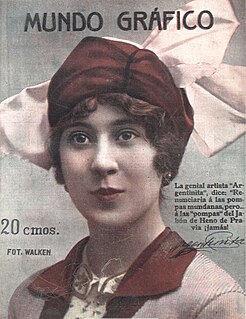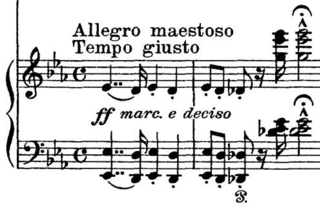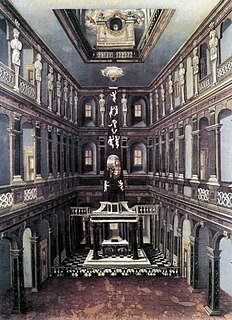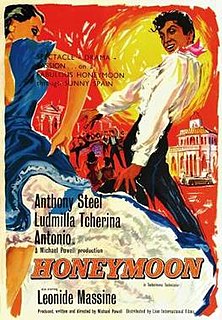Structure and analysis of the piano version
Elaborate trills at the start
The piece has an Allegro ma non troppo tempo (  =126) and is in C major. The structure of the piece is an A–B–C–A–B–C–coda form. The first section starts with 23 bars of trills from the piano. The dynamics of this section change frequently from pianissimo (pp) to mezzo forte (mf). For 14 bars, there is then a section for melody and accompaniment. Candélas then enters with two bars of "Ah!"s. The piano then follows with two bars of octave chords. There is then a question and answer section between Candélas and the piano, one bar at a time, for 17 bars. There are then trills for the piano for a further 8 bars. A quaver–quaver rest–quaver–quaver rest pattern follows with straight crotchets for 8 bars. A melody then comes in above the base rhythm for 24 bars. The piano then has a large section of chords and (mainly) quavers for 33 bars. There are then trills for one bar and another quaver–quaver rest–quaver–quaver rest pattern with a straight crotchet accompaniment for 4 bars. There are then 20 bars of more trills. A section with melody and accompaniment then follows. The above section then repeats. However, as the repeat is not complete, the third movement is then cut off half way through by an ascending scale of triplets for four bars.
=126) and is in C major. The structure of the piece is an A–B–C–A–B–C–coda form. The first section starts with 23 bars of trills from the piano. The dynamics of this section change frequently from pianissimo (pp) to mezzo forte (mf). For 14 bars, there is then a section for melody and accompaniment. Candélas then enters with two bars of "Ah!"s. The piano then follows with two bars of octave chords. There is then a question and answer section between Candélas and the piano, one bar at a time, for 17 bars. There are then trills for the piano for a further 8 bars. A quaver–quaver rest–quaver–quaver rest pattern follows with straight crotchets for 8 bars. A melody then comes in above the base rhythm for 24 bars. The piano then has a large section of chords and (mainly) quavers for 33 bars. There are then trills for one bar and another quaver–quaver rest–quaver–quaver rest pattern with a straight crotchet accompaniment for 4 bars. There are then 20 bars of more trills. A section with melody and accompaniment then follows. The above section then repeats. However, as the repeat is not complete, the third movement is then cut off half way through by an ascending scale of triplets for four bars.
Here the tempo changes to Più mosso, ma giusto. This is the coda. Semiquavers then follow for two three bar phrases of ascending scales. Candélas then has "Ah!"s at the start of every other following bar for the next four bars. These bars finish with semiquavers and then an ascending scale. There are then crotchet chords for 15 bars. A descending arpeggio and low final note finish the piece. [9]

Manuel de Falla y Matheu was an Andalusian Spanish composer and pianist. Along with Isaac Albéniz, Francisco Tárrega, and Enrique Granados, he was one of Spain's most important musicians of the first half of the 20th century. He has a claim to being Spain's greatest composer of the 20th century, although the number of pieces he composed was relatively modest.

Encarnación López Júlvez, known as La Argentinita, was a Spanish-Argentine flamenco dancer (bailaora), choreographer and singer. La Argentinita was considered the highest expression of this art form during that time.

Franz Schubert's Impromptus are a series of eight pieces for solo piano composed in 1827. They were published in two sets of four impromptus each: the first two pieces in the first set were published in the composer's lifetime as Op. 90; the second set was published posthumously as Op. 142 in 1839. The third and fourth pieces in the first set were published in 1857. The two sets are now catalogued as D. 899 and D. 935 respectively. They are considered to be among the most important examples of this popular early 19th-century genre.
In Western music and music theory, augmentation is the lengthening of a note or interval.

Franz Liszt composed his Piano Concerto No. 1 in E♭ major, S.124 over a 26-year period; the main themes date from 1830, while the final version is dated 1849. The concerto consists of four movements and lasts approximately 20 minutes. It premiered in Weimar on February 17, 1855, with Liszt at the piano and Hector Berlioz conducting.

"Der Tod und das Mädchen", D 531; Op. 7, No. 3, is a lied composed by Franz Schubert in February 1817. It was published by Cappi und Diabelli in Vienna in November 1821. The text is derived from a poem written by German poet Matthias Claudius. The song is set for voice and piano.

The Orgelbüchlein BWV 599−644 is a set of 46 chorale preludes for organ — one of them is given in two versions — by Johann Sebastian Bach. All but three were written between 1708 and 1717 when Bach served as organist to the ducal court in Weimar; the remainder and a short two-bar fragment came no earlier than 1726, after the composer’s appointment as cantor at the Thomasschule in Leipzig.
The Nocturnes, Op. 15 are a set of three nocturnes for solo piano written by Frédéric Chopin between 1830 and 1833. The work was published in January 1834, and was dedicated to Ferdinand Hiller. These nocturnes display a more personal approach to the nocturne form than that of the earlier Opus 9. The melodies and emotional depth of these nocturnes have thus been thought of as more "Chopinesque."
El amor brujo is a ballet by Manuel de Falla to a libretto by María de la O Lejárraga García, although for years it was attributed to her husband Gregorio Martínez Sierra. It exists in three versions as well as a piano suite drawn from four of its movements. Andalusian in character, its music includes the celebrated Danza ritual del fuego , the Canción del fuego fatuo and the Danza del terror. Its songs use the Andalusian Spanish dialectal modality. The plot: a gypsy in a love unreturned goes to her arts of magic to soften the ingrate's heart, and succeeds, after a night of enchantments, recitations and ritual dances, so that at dawn he awakens to love; bells proclaim her triumph.

El amor brujo or Carlos Saura Dance Trilogy, Part 3: El Amor Brujo is a 1986 Spanish musical film written and directed by Carlos Saura. It was directed and choreographed in the flamenco style by Maria Pagès. It is the third part of the Saura's flamenco trilogy he made in the 1980s, after Bodas de sangre in 1981 and Carmen in 1983. The film was screened out of competition at the 1986 Cannes Film Festival.
Bewitched Love is a 1967 Spanish drama film directed by Francisco Rovira Beleta and based on the eponymous ballet by Manuel de Falla. It was nominated for the Academy Award for Best Foreign Language Film. It was also entered into the 5th Moscow International Film Festival.
Trois novelettes are three short pieces for piano composed by Francis Poulenc.

Honeymoon, also shown as The Lovers of Teruel in the United States, is a 1959 film by the British director-writer Michael Powell based in part on the ballet El Amor Brujo by Manuel de Falla. The film stars Anthony Steel, Ludmilla Tchérina and Spanish ballet dancer Antonio, and features Léonide Massine.

Johann Sebastian Bach composed the church cantata Brich dem Hungrigen dein Brot, BWV 39, in Leipzig and first performed on 23 June 1726, the first Sunday after Trinity that year. Three years earlier, on the first Sunday after Trinity in 1723, Bach had taken office as Thomaskantor and started his first cycle of cantatas for Sundays and Feast Days in the liturgical year. On the first Sunday after Trinity in 1724, he began his second cycle, consisting of chorale cantatas. The cantata Brich dem Hungrigen dein Brot is regarded as part of Bach's third cantata cycle which was written sporadically between 1725 and 1727.

The Nocturnes, Op. 55 are a set of two nocturnes for solo piano written by Frédéric Chopin. They are his fifteenth and sixteenth installations in the genre, and were composed between 1842 and 1844, and published in August 1844. Chopin dedicated them to his pupil and admirer Mademoiselle Jane Stirling.

Paco de Lucía interpreta a Manuel de Falla is the twelfth studio album by the Spanish composer and guitarist Paco de Lucía. All the pieces were written by Manuel de Falla.

The six sonatas for violin and obbligato harpsichord BWV 1014–1019 by Johann Sebastian Bach are works in trio sonata form, with the two upper parts in the harpsichord and violin over a bass line supplied by the harpsichord and an optional viola da gamba. Unlike baroque sonatas for solo instrument and continuo, where the realisation of the figured bass was left to the discretion of the performer, the keyboard part in the sonatas was almost entirely specified by Bach. They were probably mostly composed during Bach's final years in Cöthen between 1720 and 1723, before he moved to Leipzig. The extant sources for the collection span the whole of Bach's period in Leipzig, during which time he continued to make changes to the score.
Dance of fire may refer to:
The Harpsichord Concerto in A major, BWV 1055, is a concerto for harpsichord and string orchestra by Johann Sebastian Bach. It is the fourth keyboard concerto in Bach's autograph score of c. 1738.

The Three-Cornered Hat is a 42-minute classical studio album in which the Pittsburgh Symphony Orchestra under André Previn perform the whole of Manuel de Falla's ballet The Three-Cornered Hat and, as a filler, the Ritual Fire Dance from his ballet Love the Magician. The longer work's two brief vocal passages are sung by the American mezzo-soprano Frederica von Stade. The album was released in 1983.















